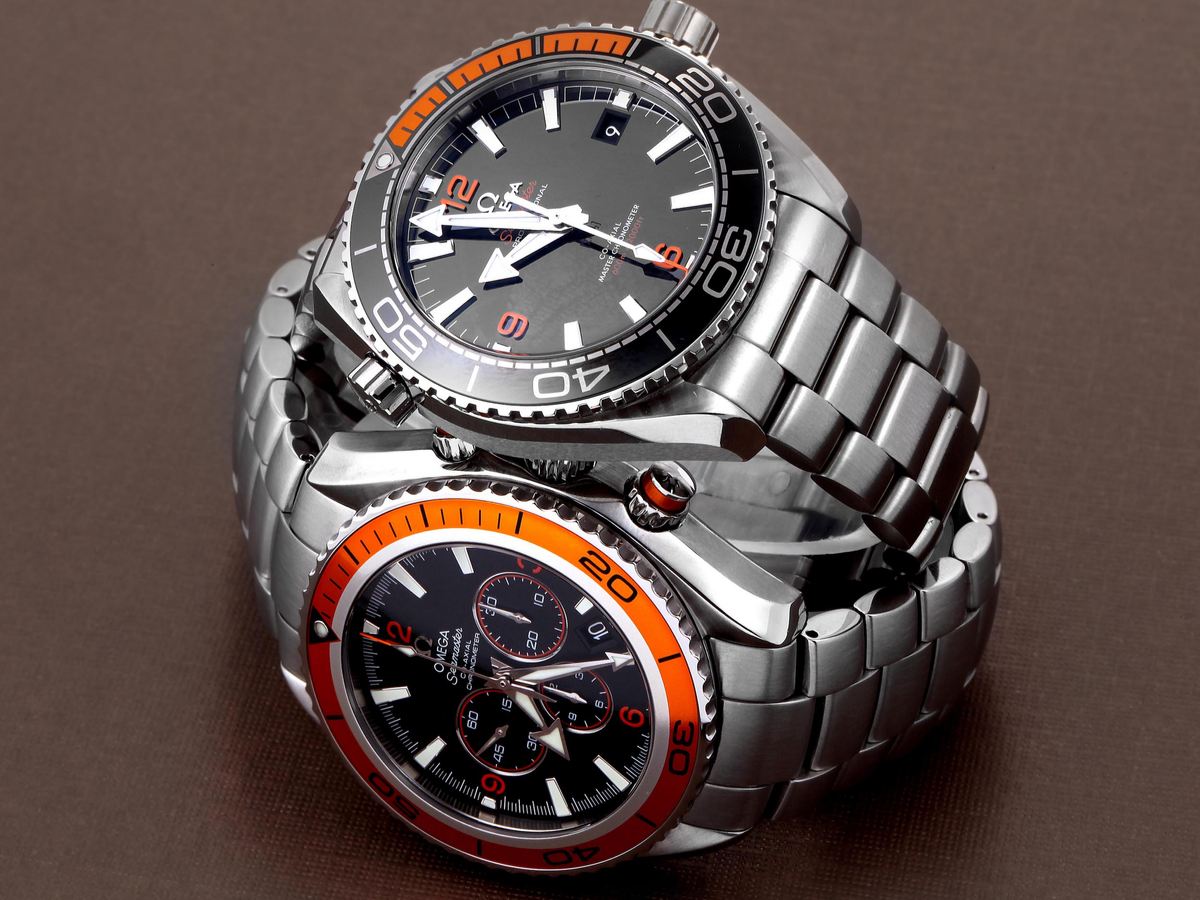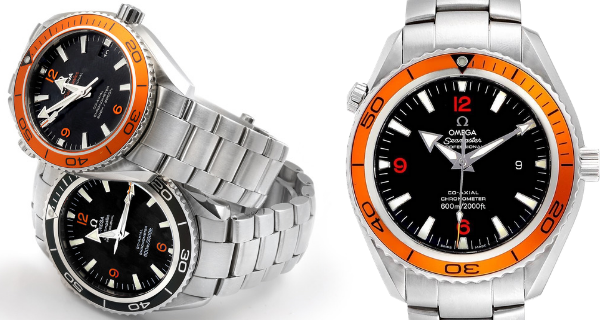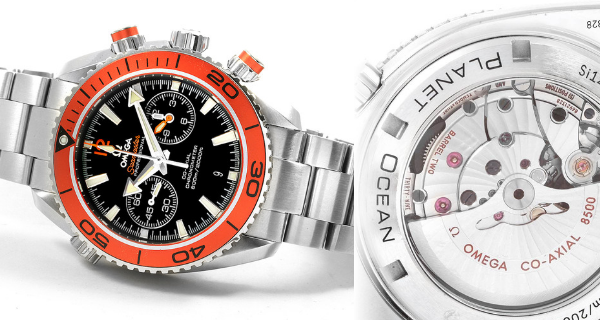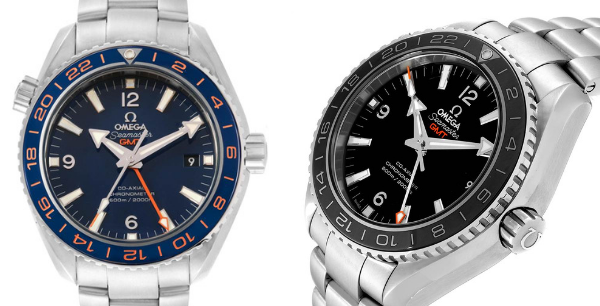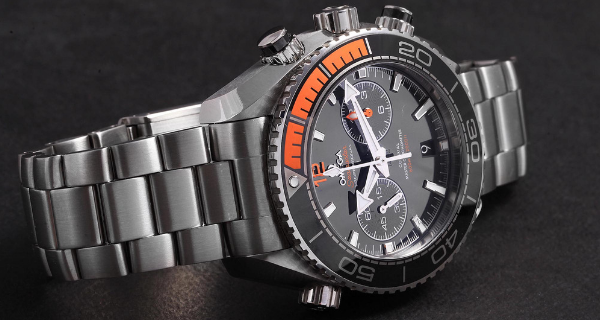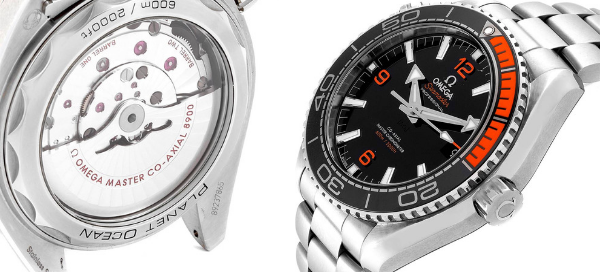The Omega Seamaster Planet Ocean has become an icon; and a leading choice among dive watches it’s often hard to imagine that it was launched just 14 years ago.
Introduced in 2005, the Planet Ocean has always been positioned as a luxury offering within the Seamaster line, but with extraordinary waterproof capabilities. These qualities, combined with a versatile design and striking orange branding, gave Omega another winner on their hands.
From just 3 models, the Planet Ocean line has grown to 27 models and more than a hundred variations. We break down the different types of Planet Ocean watches to help you decide:
|
|
First Generation (2005)
With a water resistance of 600M, the Planet Ocean comes in between the Seamaster Diver 300M and the PloProf 1200M. It was unveiled as a modern dive watch that also looks good enough for everyday, all-occasion use.
The first collection was available in two sizes: 42mm and 45.5mm. Both were equipped with aluminum unidirectional bezels, and a Helium Escape Valve for saturation diving. In 2006, Omega added the Planet Ocean Chronograph to the collection.
colors: orange and black bezel
bracelet: steel, rubber or leather
movement: Caliber 2500 / Caliber 3313 (for chronograph)
|
|
LiquidMetal (2009)
Omega has been known to test innovations on the Planet Ocean range before going full-scale. In 2009, Omega introduced the LiquidMetal to the market through the limited edition Omega Planet Ocean ref. 222.30.42.20.01.001.
LiquidMetal is a malleable protective alloy applied over the ceramic bezel. Its purpose is to protect the ceramic from discoloration, to strengthen the material, and also to fill the recessed numbers on the bezel, where dirt can sometimes accumulate.
|
|
Second Generation (2011)
Omega knew that in order to compete with the likes of the Rolex Submariner, it had to constantly improve. Five years after its launch, the Planet Ocean was equipped with a new movement and a number of aesthetic improvements.
Caliber 2500 was replaced with Caliber 8500, which adopts the use of a silicon escapement and hairspring, thus extending its power reserve to 60 hours. It also allows for an independent hour hand and finally made way for an exhibition caseback (versus the steel caseback of the first generation).
Noticeable aesthetic changes were also applied:
- Case size introduction of a 37.mm case size in addition to 42 and 45.5mm
- Color ways blue and white bezels and dials, in addition to black and orange
- Metals they also offered a Titanium model, in addition to stainless steel
- Larger and more detailed indices, hour markers, and Seamaster logo
- In some models, they also applied glossy dials and the LiquidMetal bezel
This generation of Omega Planet Ocean are considered the transitional models, where Omega tested elements that would make a more successful design language for the brand.
colors: orange and black, blue and white bezels
metals: stainless steel, titanium, and rose gold (by 2012)
bracelet: steel, rubber or leather
movement: Caliber 8500
|
|
Omega Planet Ocean GMT (2013)
In 2013, Omega introduced the GMT function to the Planet Ocean line. The Planet Ocean GMT features an independently adjustable hand that works with a 24-hour bezel and a new case size measuring 43.5mm.
It follows the design language of the Planet Ocean line, with a few enhancements to help distinguish the GMT function: an orange tipped GMT hour hand and 24-hour bezel markers, as well as an orange “GMT” line below the Seamaster text on the dial, in lieu of “Professional”.
colors: black and white, orange and blue bezels
metals: stainless steel
bracelet: steel, rubber or leather
movement: Caliber 8500
|
|
Third Generation (2016)
With the LiquidMetal bezel fully integrated into the Planet Ocean line, Omega upped the ante with the third generation design. This time, they combined LiquidMetal with galvanized rubber on the bezel, creating a look that’s striking, without the shine.
The black LiquidMetal bezel comes with a 15-minute scale that’s made of orange galvanized rubber. The dial was also changed from matte to polished black ceramic. The effect is a contrast of textures, and if the goal is to keep things interesting, Omega was successful in doing so.
|
|
- Movement Caliber 8500 was replaced with Caliber 8900. The first Master Chronometer movement from Omega, it’s accurate between 0 to +5 seconds per day, and is also magnetic resistant up to 15,000 gauss.
- Bracelet the bracelet was also refined to fit better on the wrist, to keep the watch from falling past the lugs.
Frequently Asked Questions about the Omega Seamaster Planet Ocean
What year did the Omega Planet Ocean come out?
The Omega Seamaster Planet Ocean was first released in 2005. It marked a new era for Omega’s dive watches by incorporating advanced technologies and contemporary designs.
There are currently four generations of the Omega Planet Ocean, introduced in 2005, 2011, 2016, and 2022.
How accurate is the Omega Planet Ocean?
Each generation of the Omega Planet Ocean has introduced significant advancements in dive watch design and accuracy, through Omega’s Co-Axial and METAS certified movements.
First Generation (2005): This generation was introduced with the Omega Caliber 2500, which included the Co-Axial escapement. This movement was based on the ETA 2892-A2.
Second Generation (2011): The Omega calibre 8500 was introduced, offering improved precision and durability.
Third Generation (2016): The introduction of the calibre 8900 marked a significant upgrade. This movement was the first METAS certified Master Chronometer movement from Omega.
Fourth Generation (2022): Newer models have continued to evolve in terms of both technology and design, including the new Ultra Deep sub-collection, whose models are water-resistant to 6,000 meters (20,000 feet) and meet the ISO 6425:2018 standard for saturation divers’ watches. Alongside the Caliber 8900 that powers the 600M models, the Caliber 8912 was added to the Ultra Deep models, a movement that is also Co-Axial Master Chronometer certified.
Is an Omega Planet Ocean a good investment?
How can you tell if it’s a fake Omega Planet Ocean?
In 14 years, Omega has created three major generations of the Omega Planet Ocean, culminating in three main models Planet Ocean, Planet Ocean GMT, and Planet Ocean Chronograph.
Aside from these major iterations, the collection has also expanded to include ingenious spin-off models: from limited edition James Bond models to collaborative Olympics watches, and even full-ceramic cases.
The Omega Planet Ocean may have a short history, but it has proven itself as a versatile line of watches that gets better with time.

